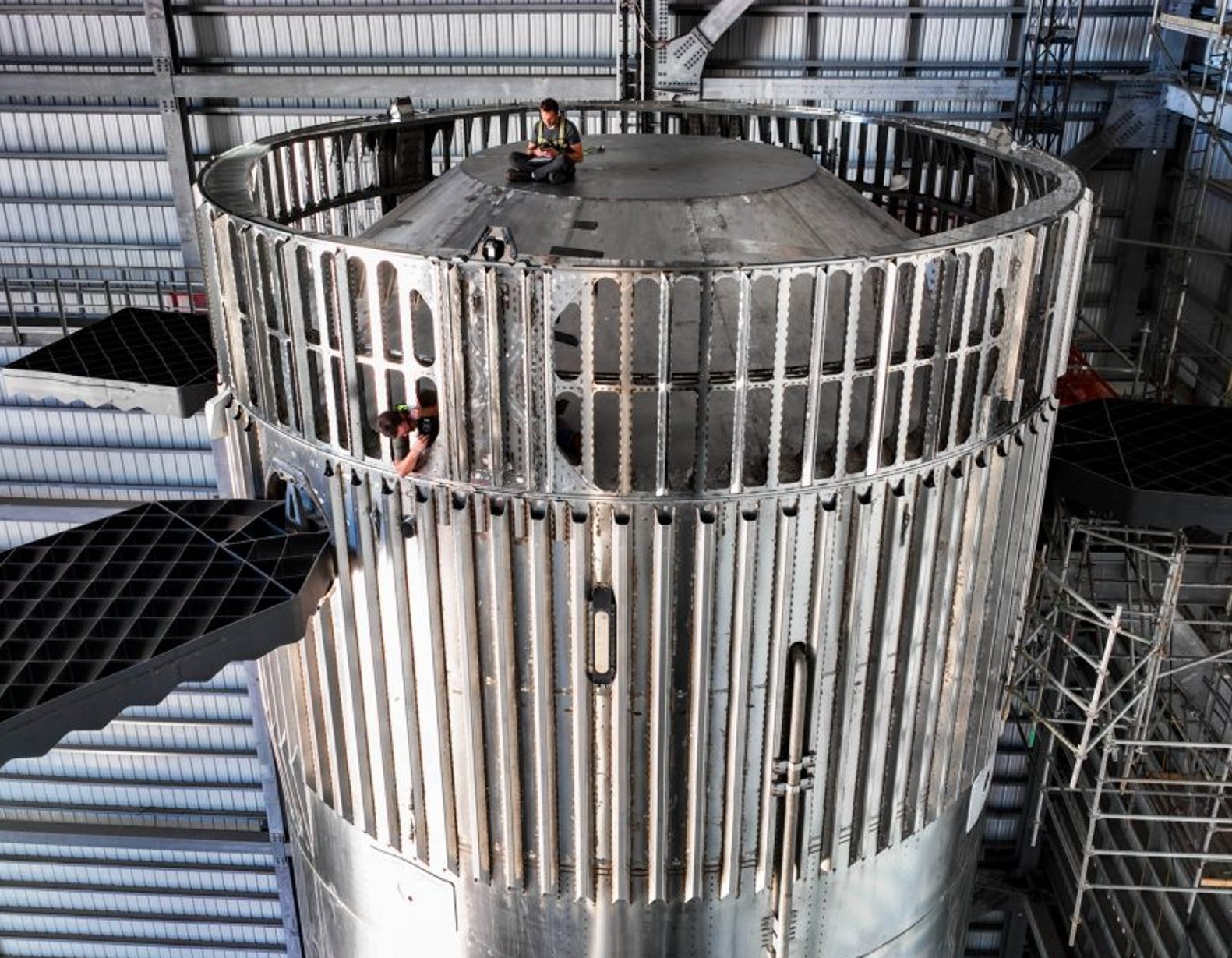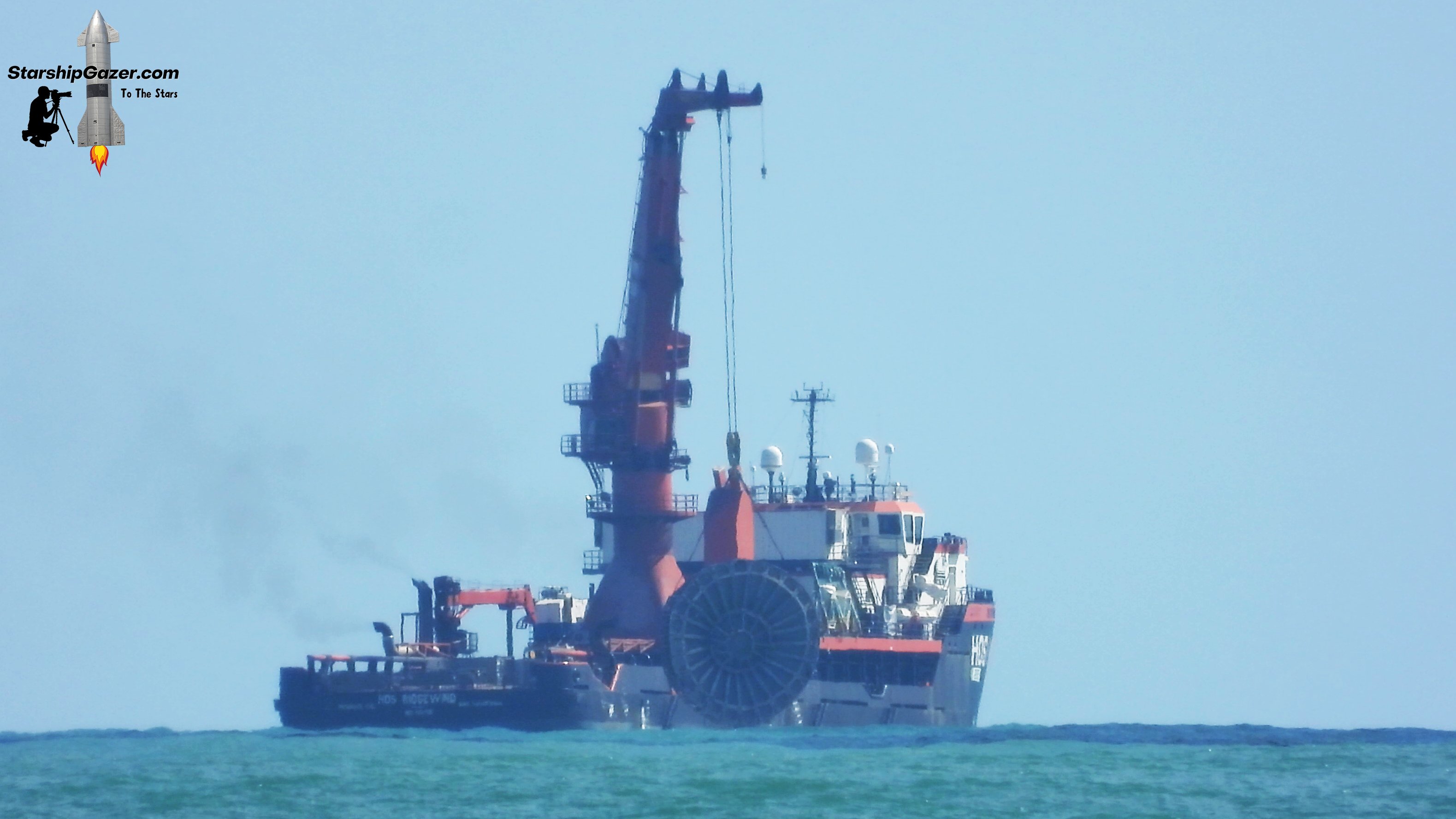I saw this picture on another site and think it does a great job showing the scale of the booster. It’s crazy how big it is.
Heh, I was considering posting that exact picture!
Above, I was ballparking that the arms could swing over 20 meters (at the radius where the booster is caught). Thought being that the booster is 9 m across, and it could swing at least double that. But 20 meters is over 65 feet! It seems a crazy far distance. And yet the arms are clearly huge from your pic. So it’s not unreasonable at all.
Anyway, I’ll just post this (older, but still basically accurate) picture:

It’s just impossible to really grasp the scale without some people in the picture.
An Economist article about how Musk’s ambition and success affects NASA.
(Limited gift link.)
(Original article.)
What the article in The Economist overlooked is that Apollo worked because its real goal wasn’t originally to land astronauts on the Moon; the original goal of the Saturn rocket program was to develop a massive lift capacity to support national strategic goals in space, including military space stations, nuclear weapons platforms in orbit (shades of Assignment: Earth) or even a permanent USAF base on the Moon! As mentioned, the Soviets were unlikely to match a crash program to land on the moon (although with much better luck it might have happened), but the point for the USA of doing so was that if it could do that, it would have the standing capacity to do almost anything else it needed to in cislunar space. What really sank Apollo was the 1967 Outer Space Treaty which kept the Cold War from spreading to space (much like the 1959 Antarctic Treaty kept that continent demilitarized and non-colonial) and shut down the “Space Race” almost without anyone noticing. By the time of the first landings the program was already coasting on inertia.
“We just put Sir Isaac Newton in the driver’s seat.”
There’s Sir Isaac’s momentum / inertia and then there’s the Federal bureaucracy’s momentum / inertia. I’m not sure what the constant of proportionality is, but it has a large exponent. ![]()
They’ve picked up the hot staging ring:

A little bent out of shape. I guess they had to verify that it didn’t land on a whale.
There’s a lot of activity at Starbase with Booster 13 and Ship 31. It’s looking like they want to fly soon. I think they’re going to use the FAA double license.
I don’t know if that’s actually proven.
There could be a very dented whale just out of frame.
![]()
I’m waiting for someone to file a lawsuit claiming that the launches inflict PTSD-like trauma on protected wildlife.
Oh, the whale-manity!
Pretty cool timelapse of Booster 7 being moved around:
Goes to show how fast they operate. Couldn’t have taken more than a couple of hours–both due to the sun and the drone battery life (15-20 min per segment). And they just drive the booster down a perfectly ordinary public road like it was nothing. No need for a specialized transporter-crawler thing.
ETA: Didn’t realize that this was a relatively old post (from 2022). Still, they operate pretty much the same way today).
I didn’t realize they ejected an interstage. Were the frowny faces smiling after? More seriously, why eject that? Cut down the weight to land the booster? The must have some way to eject it clear or it would hit the booster when the booster fires to land.
Yeah, it’s a weight saving for landing. But just temporary. Hot staging itself was basically a retrofit, so the ring (with heat shield and vents) was basically just stacked on the booster. It’s not very optimized, which is fine for the time being, but at some point they’ll integrate it with the booster. They’ve shown this pic (v1, v2, and v3 booster shown left to right):

Maybe not the final design, but it looks to be more of a truss-like system. Also, the grid fins have been moved lower down–possibly to get them out of the way of the upper stage plume. The top of the tank can probably take the heat, but the grid fin mechanism is more delicate.
A vid of the ring jettison process:
As mentioned upthread, because they don’t need to haul the launch gantry with the rocket, or solid boosters.
Definitely seems like the plan. IFT-6 is coming quick but uses S32, which is the old version. But just after is S33, a little stretched and new flaps. A side-by-side:

B33, on the left, is undergoing initial testing now. You can see that the front flaps are much smaller and moved leeward.
Just looks cleaner overall, too. The welds, the curvature of the panels, etc… just gets a little more refined on each new version. Looks like it’ll carry a payload, too (the Starlink V2 satellites).
Tiniest of nits to pick but Flight 6 will use Ship 31. I don’t think there is an S32.
Looking at them side-by-side, I wonder if the pucker between rings is something that forms over time. When it rolled out initially I don’t recall S31 having as dramatic pucker as the photo implies.
D’oh! Off-by-one error strikes again. Thanks for the correction. It does look like there’s an S32, but it’s going to be scrapped, and won’t fly on IFT-6:
Could be you’re right about the slight bulginess. I’ll have to look through some older photos. They’ve definitely improved panel fit over time, though.
Flight Test 6 announced, currently targeted for November 18:
Ars Technica article on it:
Very similar to Flight 5. However, they’ll be attempting an in-space Raptor relight (needed to prove that they can safety deorbit the ship in a controlled way), and are doing various experiments with reentry conditions, pushing them harder. As I see it, there’s a chance reentry fails on this one since it’s still using an older flap design and they’re intentionally being more aggressive. But it will be very useful data.
Back down at Starbase. Launch on Tuesday. The building I snapped before is complete, and looks pretty snazzy:

Starship itself is stacked and ready to fly:

Hoppy the Flying Water Tower has a comfortable new home on the other side of the road:

Some wise words seen in one of the buildings:

Looking forward to Tuesday, and crossing my fingers that it doesn’t get delayed further. Good vibes in the air. Campfires, etc. on the beach. Though they’ll have to head back to South Padre Island to watch.
Weather looking good for launch (currently on South Padre Island). A bit under two hours away.


